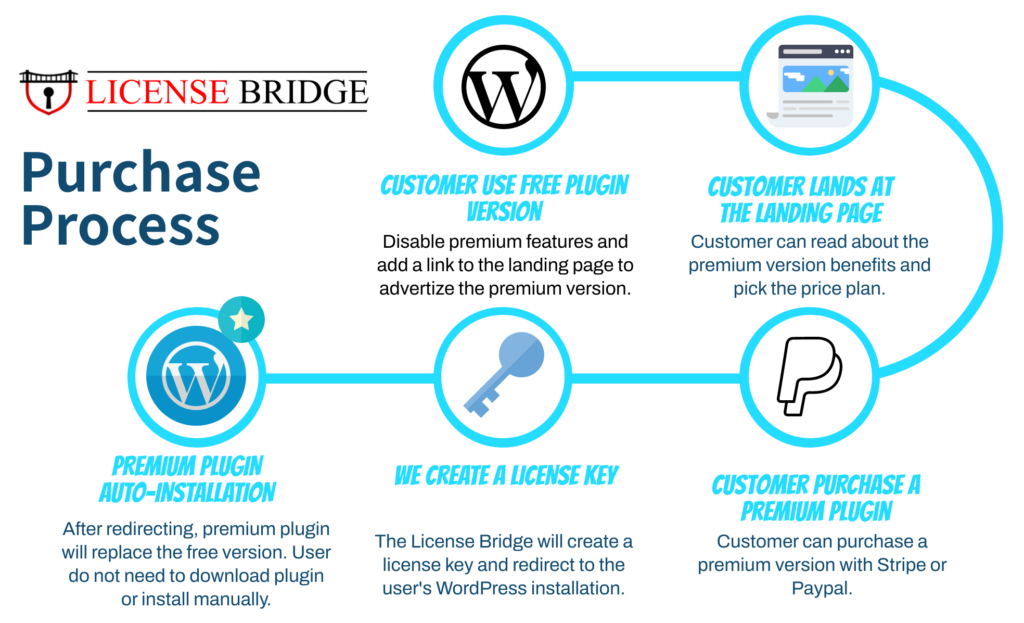In this article, I will explain all you need to create a sustainable business based on Creating WordPress Plugin and/or themes. Before we start, I want you to know that you don’t need any WordPress or Web programming skills. If you are a web developer, you can save some money down the road because you don’t need to hire people to build a product for you.

WordPress is a platform that lot of people are using for a business purposes. It can be a company blog, e-commerce store or a custom app build on top a WordPress foundation. When you create useful plugin or a beautifully and customizable theme, there is a customer who wants to use it.
When you build something that can save time, save money in the long run or improve the business, people want to pay. Build relationship with customers and provide them quality product and support. Stability is what they need. They need your support in the coming years. Invest your time to build a business you will enjoy working in the decades in front of you. You can create a WordPress theme or a plugin.
You can build a theme on top of the theme builder, just like most of the themes. Pick one theme builder and master it. Create one theme with more niche demos. You can start with few and add more demos later. Buyers want to install one niche demo that fits their own needs and do some customization if needed.
When creating a plugin you are solving your customer problem. The bigger the problem is, the price they are willing to pay is higher. Pick the important problem before you start with coding.
For both themes and plugins, pay attention to create detailed documentation. The better the documentation, is fewer time you will need to spend on supporting your clients.
The WordPress License (GPL) facts you need to know before create own plugin or a theme
You must release WordPress themes and plugins in the GPLv2 (or later) from the Free Software Foundation. Reason is the WordPress considers themes and plugins as derivative work, and they inherit the license from the WordPress.
This means that every customer who buys your plugin can:
- Use it without restriction and install it on an unlimited number of sites
- Share it with other people without restrictions
- Use your plugin/theme and re-sell it if they want
As a WordPress creator, you have to be aware of of the legal license implications. When a customer buys your product, they can do all the above and you legally can’t do anything about that. Ok, when you wrap your head around these facts, we can move forward.
This doesn’t mean you can’t build a business, it’s quite the opposite. Small percentage of people will use the legal advantage they have. Customers will pay to support your work, to get the support, and to get updates. Especially when you build a relationship with your customers. Kind and helpful support, regular updates and improvements, quick bug fixing and open relationship is a right way to build a good relationship with customers.
How to protect the WordPress plugin ?
Now we can talk about the ways to protect your work. The developers usually decide to create a Freemium WordPress plugin. Reason for that is a plugin will be listed in a WordPress directory and get free publicity and global reach. That makes a total sense.

There are a few ways to create a Freemium WordPress plugin:
- Create one version and limit access to the premium features.
- Create two separated versions, one free without premium features and one with all features included.
One plugin version with protected premium features
If you decide to create free and premium plugin in the same codebase, you will have to protect the premium features somehow. Is there a way to truly protect your code?
When you ship premium code inside, you need to ship the protection code too. Protection code is part of the code that protects premium features locked. One can read your protection code, can understand how it works, and break it. Main idea is to make the protection code unreadable, but keep everything else readable, because users want to read your plugin code in order to extend it.
Ways to make the code unreadable are:
Minifiers – remove unnecessary parts of the code, stripping the comments and the white space from the source. Also, they can use some encrypt methods in combination with the eval method. Cons – it is straightforward to decode and get a readable source.
Obfuscators – convert source code into equivalent code, but harder to understand. It will rename variables, methods with meaningless names, which makes it harder for a user to crack the code. Despite that, it is doable with a bit more effort. WordPress community users often want to read your plugin code, understand it to extend it, and overload some functionality in the theme. If you use this method, just obfuscate the part dedicated to protecting the premium code, but keep in mind that it is still not the perfect solution you seek.
Encoders – compile PHP source code to Zend opcode and store it into the files you deliver to the users, keeping the source only for yourself. When using encodes, users have to have installed decoders on hosting, which is a bummer. Shared hosting does not allow decoder installation, and installation can be cumbersome for most users. I recommend you to use encoders only if you manage web hosts for your users. It is mostly not a case if you build a WordPress plugin unless you build CRM or accounting software you plan to sell to the companies with an included hosting solution.
To wrap up, for WordPress plugins, Minifiers and Obfucators offer low protection, while the Encoder is not a practical solution for the WordPress community.
There is another way to protect your plugins and themes. The license key protection.
Protection with license key
The solution that offers high protection and doesn’t restrict your users is license key protection. For every client, you generate a unique license key once a user purchases a plugin. The License Key has to be validated every time a user wants to update to a newer version. The license key creation and validation need to be on a remote server, and communication between plugin and server needs to be secured.
I would recommend to create two separate plugin versions, one free and one premium. Combining that with license key protection gives a best results.
To get a premium version, users will have to have a valid license key. Next time when user wants to upgrade to new plugin version again valid license key is required. Critical point is that remote license service validates license keys and delivers an update.
This is where the License Bridge jumps in. We are that license key validation service, and much more.
How License Bridge can save your time?
The License Bridge will not only license key protection service but a selling software platform.
With License Bridge you will get:
– a landing page for your product
– Secured payment integration with Stripe/Paypal
– Deployment integration with GitHub/Bitbucket
– Auto-install after license key purchase
Landing page
Every product has own landing page you can use for promotions. You can add your product description, images and videos to customize it. Also, there is a space for your plugin/theme changelog version history.
We read your plugin/theme header to extract information about your plugin version, which WordPress version you support, last update and more and display all of that on a landing page.
You can create a screenshot gallery for your product to allow customers to view your product before a purchase.
Secured Payment
The secure payment is integrated into the landing page. We support Stripe and PayPal integration. All you have to do is to connect your Stripe or/and PayPal account with License Bridge and we will do all the rest. We will even create the payment plans for you. Check out our documentation page to read more about payment plans auto creation.
Deployment and auto-update
We support integration with GitHub and Bitbucket. You keep your code in a repository, and once you push the changes into the GitHub or Bitbucket repository customers with the license keys will get an automatic update.
Auto-installs
Your customer won’t need to install premium plugin manually. Once they purchase a license key for your product, if they are referred from the free plugin version, we will install the premium plugin version automatically. Yes, sounds like a magic I know.
This is how a license key purchase process looks like:

Set up the landing page, connecting the payment provider, creating a payment plans and integrating the repository is something you can do quickly. Once you finish, you can start selling your licenses. I created a License Brige with an idea to help you save the precious resource on the planet – our time. You can focus on your product, and leave the license protection, secured payment, landing page and deployment process to us. And that is how you can start selling WordPress plugin or theme in 10 minutes.
Sign up to the License Bridge for FREE, and start your business right now.


